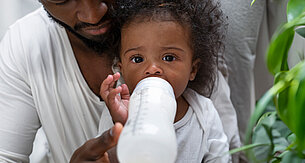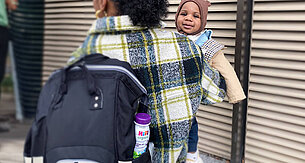Cows' milk protein allergy

It’s estimated that around 7% of babies under one are allergic to cows’ milk protein, making it one of the most common childhood food allergies. It can affect breastfed babies via their mother’s diet, but more commonly cows’ milk allergy (CMA) develops when cows’ milk is first introduced to a baby’s diet, i.e. in formula milk or during weaning.
How do we know it’s CMA?
First of all, if you suspect a cows’ milk allergy, or even if you’re just worried about the symptoms your baby is experiencing, you should talk to a GP. Don’t self-diagnose.
Diagnosing a cows’ milk allergy is usually done through an elimination diet – meaning, you take dairy out of your baby’s diet and see how symptoms manifest. If the symptoms disappear, you gradually reintroduce cows’ milk back into the diet and see whether symptoms reappear. This can be a slow and painful process, but is worthwhile to achieve a diagnosis and get to a place where your baby is no longer uncomfortable. It’s also worth noting that most children will grow out of their allergy, so won’t need to avoid dairy forever.
When babies who are allergic to cows’ milk protein come into contact with it, they can react in two ways: so-called ‘immediate CMA’, where symptoms begin within minutes of ingestion, and ‘delayed CMA’, which could take hours or days to show up. The latter is clearly more difficult to diagnose, hence why it is important to carry out testing under GP guidance.
Symptoms of cows' milk allergy
Cows’ milk allergic reactions range in severity and symptoms from one child to the next, but could include:
- Itchy, blotchy or swollen skin, or eczema that doesn’t improve with treatment
- Tummy pains, diarrhoea, constipation and/or sickness
- Congestion and hayfever-like symptoms
Rarely, CMA can cause severe allergic symptoms that come on suddenly, such as difficulty breathing. This should be treated as an emergency. Call 999 for an ambulance immediately if you think your child has anaphylaxis (even if they start to feel better).
Treatment for CMA
Once CMA has been confirmed by a GP, treatment is basically to avoid cows’ milk products. If breastfeeding, this means no more dairy for mum, which can be difficult, but given the range of vegan and dairy-free products in the supermarket these days, is less challenging than it used to be. If your baby is formula-fed, the GP will prescribe special infant formula that is dairy-free.
Going forward, your baby will likely be referred to a dietician who will follow up with you around every 6 – 18 months to see if your child is showing signs of growing out of the allergy. Again, testing this will involve the gradual reintroduction of dairy via a system known as the ‘milk ladder’, to see whether symptoms recur.
For further information, visit the NHS website, which has lots of information on cows’ milk protein allergy and lactose intolerance.





